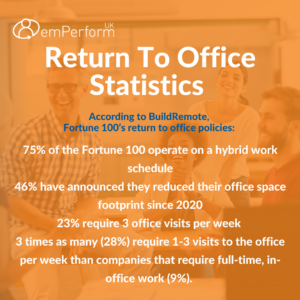
In recent times, the world of office work has undergone significant shifts, with remote work becoming the norm for many. As companies now navigate the return to office life, understanding the benefits and challenges is crucial. Delve into the pros and cons of Return to Office and learn effective strategies for easing this transition for your employees.
The Debate
As the workplace evolves, the debate over returning to full time office work versus maintaining a hybrid model intensifies. In March 2024, Boots announced a mandatory 5 day in office work policy starting in September, moving away from their previous 3 day hybrid approach. CEO Seb James believes the office is a “more fun and inspiring place,” fostering better engagement and creativity. This view contrasts with the rising adoption of flexible work models by 66% of UK companies this year.
Advocates for full time office work, including Boots, Dell, Disney, and Starbucks, argue that hybrid schedules lead to inefficiencies and wasted resources from underutilised office spaces. They claim a full time office presence enhances collaboration, team cohesion, and company culture. However, the UK’s Flexible Working Bill complicates this argument by enforcing strict return-to-office policies, as hybrid work has become prevalent.
Talent acquisition is another crucial factor. According to Gartner’s Q2 2023 survey, 56% of candidates prioritise flexibility in work location and schedule over higher pay. This highlights the need for flexibility to attract and retain top talent.
As organisations navigate the RTO transition, they must carefully consider the benefits and challenges of both models to determine the best approach for their workforce.

The Benefits of Employees Returning to Office
Envoy’s survey findings reveal compelling insights into current workplace dynamics. An immense 88% of companies are utilising incentives to encourage their workforce back onsite. Additionally, 77% have embraced hybrid working models, with “at-will” hybrid policies proving the most popular. For many offering incentives is worth it as bringing employees back to the office offers numerous advantages that extend beyond mere physical presence:
Live Experiences and Observations
Working onsite provides the advantage of real time observation and feedback, enabling managers and colleagues to quickly identify and address issues. This immediate interaction supports prompt assistance, enhancing the team’s overall responsiveness. Onsite work promotes high accountability and ensures tasks are executed efficiently and effectively through instant feedback. According to a study by McKinsey, companies with more collaborative work environments are five times more likely to be high performing. To further enrich the feedback process and foster continuous improvement, utilise emPerform’s ongoing feedback solution. This comprehensive tool gathers insights from multiple perspectives, driving performance enhancement and supporting professional development. Incorporating both online and in person feedback allows employees to use the forum they find most comfortable.
Work Life Balance
Returning to the office can re-establish clear boundaries between work and personal life, contributing to a healthier work life balance. A dedicated workspace outside the home allows employees to focus better during work hours and disconnect more effectively afterwards. According to a CIPD survey, companies that prioritise work life balance see a 56% increase in productivity. The physical separation provided by commuting to an office reduces the blurring of work and personal responsibilities common in remote settings, leading to improved concentration and efficiency during the workday.
For a successful return to the office, it is essential to provide employees with well equipped workspaces and areas for breaks. These spaces enhance productivity and well being by offering a comfortable working environment and opportunities for relaxation. This structured office environment supports better focus, routine, and social interaction, fostering a more engaged and productive workforce while promoting a balance between professional and personal lives.
Mentorship
The office environment naturally fosters mentorship opportunities. Seasoned employees can provide guidance, share insights, and support career development through direct interactions and informal coaching sessions. Learning from others is highly effective, especially for those just starting out in their careers. Having a mentor who offers one-on-one feedback and guidance is invaluable. For more information on mentoring for employee development, consider our “Mentoring for Employee Development” blog.

Why some employees are reluctant to return to the office
Despite the eagerness of some, many employees harbour reservations about returning to traditional office settings. Addressing these concerns is pivotal to fostering a positive working environment.
Commuting
For many employees, commuting is a significant deterrent to returning to the office. Long and stressful commutes can consume valuable time and energy, leading to reduced productivity. During the pandemic, remote work eliminated this daily struggle, providing employees with more personal time and flexibility. The thought of returning to hours spent in traffic or on crowded trains is challenging for many, especially those who have optimised their routines around remote work. Employers should acknowledge these concerns and consider flexible commuting solutions or hybrid models to minimise this challenge.
Distracting Co-Workers
The office environment can be rife with interruptions, with chatty co-workers being a main source of distraction. While social interactions can enhance workplace culture, they can also impede concentration and productivity. Employees who have thrived in the focused environment of remote work may find the return to an office filled with casual conversations disruptive. Creating quiet zones, promoting a culture of respect for personal work time, and integrating more private workspaces can help balance social interaction with the need for focus.
Inadequate Working Facilities
For some, home offices have evolved into well-equipped workspaces tailored to individual requirements. Returning to a standard office environment that may lack the same level of comfort or functionality can be a significant drawback. Issues such as inadequate furniture, insufficient privacy, or outdated technology in the office can make the transition back feel like a step down in working conditions. To combat this, employers should invest in modernising office facilities and consider personalising workspaces to meet individual needs.
Lack of Flexibility
Remote work has redefined what flexibility means for employees, offering the ability to tailor work schedules around personal commitments and peak productivity periods. Many employees are reluctant to return to rigid office schedules that offer less autonomy over their workday. Flexibility has become a pillar of job satisfaction, and its absence in traditional office setups can make the return feel restrictive. According to Gallup, on average, employees prefer to be in the office two to three days per week and this schedule tends to optimise employee engagement for many roles. To address this, companies should consider adopting flexible working hours or a hybrid model that allows employees to choose where and when they work best.
Care Responsibilities
One significant reason for reluctance is care responsibilities. Many employees, especially those with young children or elderly family members, found remote work beneficial in balancing their professional and personal duties. The flexibility to manage care tasks during breaks or non peak hours without the need for commuting has been a substantial relief. Returning to the office full time can reintroduce logistical challenges, including arranging additional childcare or eldercare, which may be both costly and stressful.
Consider emPerform’s anonymous survey feature to understand why employees may be hesitant to return to the office. This tool can provide valuable insights into their concerns and preferences, allowing you to identify key issues and develop targeted strategies to address them. By listening to employees’ feedback anonymously, you can create a more supportive and appealing work environment that encourages their return.

Tips for a Successful Return to Office
Promote Collaboration and Innovation
Face to face interactions frequently spark spontaneous idea exchanges, crucial for fostering innovation. Promote a culture of teamwork by organising collaborative projects that allow employees to combine their varied skills and perspectives. Design office spaces to facilitate these interactions, including open-plan areas, dedicated meeting rooms, and informal lounges that inspire casual conversations and creative thinking. Additionally, plan team building activities to strengthen these connections and encourage a cohesive, innovative environment.
Make Employee Wellness a Priority
A comprehensive strategy for employee wellness addresses both mental and physical health. Introduce wellness initiatives featuring routine health check-ups, mental health resources, and fitness options. Flexible scheduling is essential to alleviate stress and support a healthy work-life equilibrium. Provide ergonomic workspace arrangements to minimise physical discomfort and boost overall comfort.
Phased Return to Work
A gradual return to the office can help mitigate the stress and uncertainty associated with significant changes in work routines. Start by increasing onsite days incrementally, allowing employees to adapt at a manageable pace. This approach helps identify and address any challenges that arise during the transition and provides time for employees to reacclimate to the office environment. Communicate the phased return plan clearly and provide flexibility within it to accommodate individual needs.
Reasonable Adjustments
Recognise that a one size fits approach may not suit every employee. Provide flexible hours, remote work options when possible, and accessible facilities to meet diverse needs. This includes making accommodations for those with disabilities, caregiving responsibilities, or other personal circumstances that impact their ability to adhere to traditional work hours or locations. Under the New Flexible Working Act, employees can now make a statutory request for permanent changes to their contract from day one of their employment. This legislation empowers them to seek modifications in their work hours, duration, and location right from the start. Discover more about this act in our previous blog.
Creating an Inclusive Workplace
Ensure that your policies reflect a commitment to inclusivity and accessibility. Regularly review workplace practices to identify areas where additional accommodations might be needed and engage with employees to understand their specific requirements. Providing the necessary adjustments not only supports individual employees but also fosters a more inclusive and supportive work environment overall.
Create a Culture of Convenience
Make the office a place where employees enjoy spending time by offering amenities that enhance comfort and convenience. This can include a central and easily accessible location, modern technology, and comfortable workspaces that cater to different working styles, such as quiet zones, collaborative areas, and relaxation spaces.
Transport Subsidies, Free Food, etc.
Providing free meals or snacks can significantly boost morale and contribute to a positive atmosphere in the office. Whether it’s a fully stocked snack bar, daily breakfast options, or occasional catered lunches, these benefits can make the workday more enjoyable and foster a sense of community among employees. Consider offering transport subsidies or other commuting benefits to reduce the financial burden on employees and make the commute more manageable.
Salary Increase
Recognising and rewarding employees for their commitment to onsite work through financial incentives can underscore the value of their presence in the office. This may include salary increases, bonuses, or performance based rewards that celebrate their contributions and dedication. Leveraging emPerform’s ongoing feedback and performance journal simplifies this process, providing a structured way to track achievements and ensure that rewards are aligned with performance.

As the debate over full time Return to Office (RTO) versus hybrid work continues to evolve, each model has its distinct advantages and challenges. Full time office work can enhance collaboration, mentorship, and work-life balance, while hybrid models offer flexibility and convenience that many employees have come to value.
Employers must consider the diverse needs and preferences of their workforce to navigate this transition effectively. The goal is to find a balance that maximises productivity, employee satisfaction, and organisational efficiency. By listening to employees, providing necessary adjustments, and fostering a culture of collaboration and wellness, companies can successfully manage the return to office and ensure a positive and engaging workplace for all.
If you want to streamline your employee review processes and easily manage your company’s goals, it can be easily achieved with emPerform. Book a FREE demo today or contact us for any advice on performance management.


Recent Posts